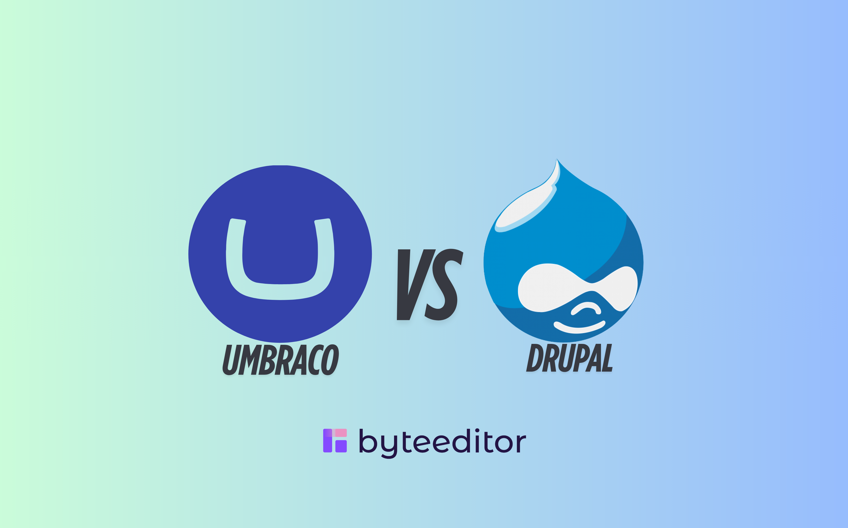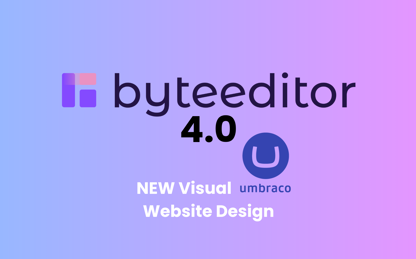
- 06 Jun 2025
Umbraco vs Drupal
With so many content management systems out there, choosing between enterprise-grade platforms like Umbraco and Drupal can be tough. Both serve large organizations and complex websites, but they take fundamentally different approaches to content management and development. This comparison will help you decide which platform aligns better with your business needs, technical requirements and long-term goals.
Introduction: Umbraco vs Drupal Overview
Umbraco, known as "the friendly CMS", is an open-source content management system built on Microsoft’s .NET framework. With over 730,000 active installations worldwide, Umbraco has become a powerful enterprise solution that focuses on clean architecture and developer-friendly workflows.
The platform is content-first with strong separation of content and presentation, making it perfect for organizations that value long-term maintainability and scalability.
Drupal is a mature, open-source CMS built on PHP that has been serving enterprise clients since 2001. Known for its flexibility and robust content modelling capabilities, Drupal powers millions of websites including government portals, universities and large corporations.
Drupal’s modular architecture allows for extensive customization through its vast ecosystem of contributed modules, making it a popular choice for complex, content-heavy websites with intricate user workflows.
Key Differences:
The fundamental difference between Umbraco vs Drupal lies in their technology and architectural approach.
Technology Stack
- Umbraco: Built on .NET Core/Framework, uses C#, runs on Windows or Linux, supports SQL Server, MySQL, or SQLite
- Drupal: Built on PHP, runs on LAMP stack (Linux, Apache, MySQL, PHP), cross-platform compatibility
Architecture Approach
Umbraco follows a code-first approach where developers have complete control over the markup and can create custom document types tailored to specific content needs. This results in cleaner, more maintainable code structures.
Drupal employs a configuration-driven approach with extensive use of modules and hooks. While this provides flexibility, it can lead to complex interdependencies and potential performance bottlenecks as sites grow.
Ease of Use and Content Management
When evaluating any CMS platform, ease of use is one of the main factors we consider, especially when teams include both technical and non-technical users working together.
Admin Interface and Dashboard Overview
Your team's productivity depends heavily on how intuitive the admin interface is, which is why it's crucial to take a proper look at both platforms.
The Umbraco Backoffice uses a clean, tree-structured layout that feels natural to navigate. Content is organized in a clear hierarchy, making it easy to find what you're looking for. The interface, once configured, shows a nice balance - it's flexible enough for developers but doesn't intimidate content editors. You can customize dashboards based on user roles, so everyone sees exactly what they need to do their job effectively.

On the other hand, Drupal's administrative interface is incredibly powerful, but that power comes with complexity. New users often feel overwhelmed by the sheer number of options and configuration screens. While recent versions have made significant improvements to the user experience, there's still a steep learning curve that can slow down content teams, especially those without technical backgrounds. 
Content Management and Editing
If we talk about content management and editing, this is where your team will spend most of their time daily.
Umbraco's content editing feels intuitive and streamlined. The Block Grid Editor gives content creators flexibility to build engaging layouts while maintaining consistency. Once developers set up the content types, editors can focus on creating content without worrying about breaking the design.
The editing process can become even more intuitive with visual page builders. ByteEditor is a specialized tool designed for Umbraco CMS, offering a visual page builder that transforms the complexity of block grid layout into an intuitive interface. Allows the editors to work with content blocks through simple drag-and-drop functionality.
Drupal's content management is undeniably powerful with complex content relationships and custom field configurations. However, setting up these relationships requires solid technical knowledge, and the editing interface can feel overwhelming for everyday content tasks.
To bridge the gap for non-technical users, Layout Builder is Drupal’s main solution for visual page editing. While it allows content creators to manage layouts and components within the admin interface, it can still be challenging to use without developer configuration, especially when it comes to creating reusable design systems or editorial guardrails.
Multilingual Support and Capabilities
For businesses serving global audiences, multilingual capabilities are essential. Here's how both platforms handle this challenge.
Umbraco's approach to multilingual content is elegant and practical. The Language Variants feature lets content editors manage different language versions of the same page right from one interface. When you enable multiple languages, a simple dropdown appears that lets you switch between languages to add or edit translated content.

Drupal offers comprehensive multilingual capabilities through its contributed modules ecosystem, including translation workflows and language-specific content routing. While powerful, the setup and maintenance can be complex.

SEO Capabilities in Umbraco vs Drupal
Umbraco SEO
Umbraco offers a solid SEO foundation with features like clean URLs, automatic 301 redirects, and HTTPS support. Advanced functionalities such as XML sitemaps, Open Graph tags, and structured data typically require developer setup. However, tools like ByteEditor simplify SEO management, providing an intuitive interface that allows content editors to optimize pages without technical expertise.
Drupal SEO
Drupal SEO offers a robust set of SEO tools through its module system, Modules like Pathauto generates SEO friendly URLs, Metatag manages metadata SEO friendly URLs, Metatag manages metadata and XML Sitemap helps with site indexing. The Redirect module ensures proper URL redirection and preserves SEO value when content is updated.
Performance, Security, and Scalability Comparison
Development Comparison
Umbraco Development:
- Razor-based templating with flexible page and block system
- Highly extensible C#.NET backend architecture
- Pre-built integration capabilities with headless content API and web hooks configuration
- Strong platform ecosystem: Umbraco Cloud, Umbraco Commerce, Umbraco Engage, Umbraco Workflow, Umbraco Deploy
- Focused Developer plugin ecosystem
Drupal Development:
- Extensive hook system
- Large contributed module ecosystem
- Complex but flexible theming system
- Steeper learning curve for new developers
Plugins and Packages for Umbraco VS Drupal
Umbraco Package Ecosystem: The Umbraco marketplace offers curated, high-quality packages that are typically well-maintained and documented. While smaller than Drupal's ecosystem, packages tend to be more reliable and easier to integrate.
Drupal Module Ecosystem: Drupal boasts over 45,000 contributed modules, providing solutions for virtually any functionality. However, module quality varies significantly, and dependency management can become complex in large projects.
Scalability in Umbraco vs Drupal
Umbraco Scalability: Built on .NET Core, Umbraco offers excellent performance under load with efficient memory management and built-in caching mechanisms. The platform scales well both vertically and horizontally, with cloud-native deployment options.
Drupal Scalability: Drupal can scale to handle high-traffic websites but often requires significant optimization and caching strategies. Performance can degrade with complex module interactions and extensive customizations.
Security in Umbraco Vs Drupal
Umbraco Security: Benefits from .NET's robust security framework with built-in protection against common vulnerabilities. Regular security updates and a smaller attack surface due to lower market share contribute to its security posture.
Drupal Security: Has a dedicated security team and regular security advisories. However, the extensive module ecosystem can introduce vulnerabilities, requiring careful module selection and regular updates.
Integrations
Umbraco is great at integration within the .NET ecosystem, it has seamless connections to Microsoft services, Azure cloud platforms, and various enterprise systems. It supports RESTful APIs and headless CMS capabilities for modern integration patterns.
For this Umbraco has Content Delivery API, which is the built-in headless capability to manage content access in JSON format, and present it across different channels, supporting secure access through API key authentication and offering extensive customization options.
Umbraco also includes Webhooks for real-time integration. Webhooks are important for enabling external services to react to changes in content instantly by sending HTTP requests. This process allows integration with third-party services and workflow automation for content modifications.
Drupal Integrations: Strong integration capabilities with various third-party services through contributed modules. The REST API and JSON:API modules enable headless implementations and external system connections.
Hosting, Support, and Costs
Umbraco: Built on ASP.NET, Umbraco typically requires Windows hosting with .NET support and an MS SQL Server database. It's compatible with cross-platform setups via .NET Core or Docker. Hosting options like Umbraco Cloud, running on Microsoft Azure.
Drupal: operates on the standard LAMP stack (Linux, Apache, MySQL, PHP), making it widely compatible and cost-effective.
Support Options
- Umbraco: Official support through Umbraco HQ, active community forums, and certified partner network
- Drupal: Large community support, commercial support options, extensive documentation
Total Cost Considerations
While Drupal hosting may be initially cheaper, Umbraco often provides better long-term value through reduced maintenance costs, faster development cycles, and improved performance efficiency.
Why Umbraco is the Best Drupal Alternative
Performance Advantages Over Drupal
Speed and Efficiency: Umbraco consistently outperforms Drupal in speed benchmarks due to .NET's compiled nature and efficient memory management. Pages load faster, and server resources are utilized more effectively.
Maintenance Overhead: Umbraco requires significantly less maintenance than Drupal. Updates are straightforward, and the codebase remains cleaner over time without the complexity of interdependent modules.
Developer Productivity: The modern development environment, strong typing, and excellent tooling in Umbraco lead to faster development cycles and less bugs compared to Drupal's complex hook system.
Long-term Stability: Umbraco's architecture promotes sustainable growth without the technical debt that often accumulates in large Drupal installations.
Who Should Choose Umbraco vs Drupal?
Choose Umbraco if you:
- Work with Microsoft technologies or prefer .NET development
- Need superior performance and scalability
- Want cleaner, more maintainable code architecture
- Require a modern Drupal alternative with better developer experience
- Plan for long-term growth and reduced maintenance overhead
Choose Drupal if you:
- Have existing PHP/Drupal expertise in your team
- Need extensive out-of-the-box functionality through modules
- Require complex content relationships and workflows
- Work in government or sectors where Drupal is established
Pros and Cons Umbraco vs Drupal
Umbraco Pros:
- Superior performance and scalability
- Clean, maintainable architecture
- Modern development experience
- Strong security foundation
- Excellent long-term value
Umbraco Cons:
- Smaller package ecosystem
- Requires .NET development knowledge
- Higher initial development investment
- Most of the features need custom code
Drupal Pros:
- Extensive module ecosystem
- Mature platform with long history
- Large community and resources
- Flexible content modeling
- Strong multilingual capabilities
Drupal Cons:
- Performance challenges with complex sites
- High maintenance overhead
- Steep learning curve
- Module dependency complexity
- Potential security vulnerabilities
Conclusion on Umbraco vs Drupal
The decision between Umbraco vs Drupal relies on your technical requirements and capability, team expertise, and long-term business vision.
Umbraco stands out for being a great choice for organizations seeking a modern, performant, and maintainable solution. Its .NET foundation provides strong performance, security, and developer flexibility over Drupal’s PHP-based architecture.
For teams looking for a migration alternative from Drupal, Umbraco is a great choice. Offering a compelling combination of enterprise features, scalability, and long-term value.






